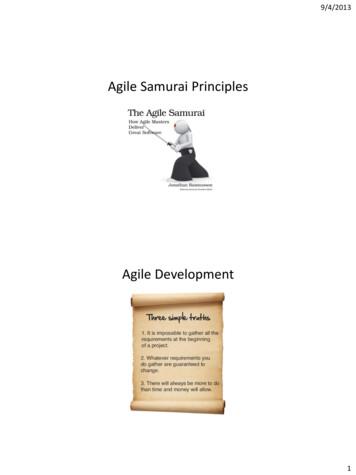Agile Change Management
Agile Change Management It ain’t waterfall reheated 1
Agenda History of Agile Change Management Agile vs. Waterfall Change Management Agile Tools of the Trade Questions 2
People First Workable Software Collaboration Responding to Change 3
Organizational Change Management A brief history and prevailing models Kotter’s 8-Step Prosci’s ADKAR 4
Agile and Organizational Change Management TRADITIONAL AGILE Overall Goal Efficiently produce solutions that improve business outcomes and satisfy stakeholders Same! Approach Linear Cyclical Business Requirements Defined at the beginning of a project Evolves over time Stakeholder Engagement Engaged at the start of the project (requirements), at the end of the project (testing), and if you are lucky, at key points during the project through communications Engaged throughout the project Time to Business Value At the end of the project Ongoing, throughout the project * Managing Change in an Agile World; Nelson, Kate, Giannitelli, Gina, Stautberg Shannon, 2018, p. 16 5
OCM in an Agile World 6
What does agile OCM look like? Mapping stakeholders, risks and impacts early Providing a Business Case for the change Being specific about the “as is” and “to be” Preparing sponsors to manage resistance Communication, communication, communication 7
Agile vs. Waterfall Change Management 8
Change occurs on 3 levels Project Release 9
Project Level Articulate a crystal-clear vision Assess environment Engage and enable sponsors Communicate, communicate, communicate Discuss people risks in ceremonies 10
Sprint Level Capture and reflect the voice of the customer Engage “real” users throughout Communicate, communicate, communicate Discuss people risks in ceremonies 11
Release Level Sponsors lead the change Prepare users for what’s coming Demo the change Capture and respond to feedback Learn, rinse, repeat 12
What Agile Change Management isn’t A reheat of waterfall OCM Huge plans spanning long timeline Static templates and lots of docs Slow-rolled messages Long training on complete solution 13
Agile Tools of the Trade 14
Change Agility Agile change management follows Agile methodology 15
Change Canvas 16
Blast Radius 17
Personas 18
Kanban Boards 19
Lean Coffees 1. Set up Kanban - 5 minutes 2. Meeting Kickoff - 2 minutes TOOLS Sticky Notes Markers Timer Wall or Screen 3. Brainstorm Topics - 5 minutes 4. Pitch Topics - 10-15 seconds each 5. Vote - 3 minutes TECH Trello Leancoffeetable.com Ideaboardz.com Stopwatch app 6. Prioritize Topics - 2 minutes 7. Discussion (Time Boxed) - 6 to 8 minutes each 8. Roman Voting - 15 seconds MORE INFO LeanCoffee.org AgileCoffee.org 9. Continue or Next Topic - Continue – 4 mins Next Topic – Step 7 20
Questions? 21
Resources Agile Change Management 101: A Crash Course 5 Implications for Change Management in an Agile Environment How to incorporate change management into Agile projects
Agile Change Management 101: A Crash Course 5 Implications for Change Management in an Agile Environment How to incorporate change management into Agile projects: Resources: Title: Agile Change Management Author: Austin Kirkbride Created Date: 12/2/2019 10:13:36 AM Agile Arizona 2021 is a two-day virtual conference for Scrum and .
1. The need for an agile way of working 6 2. The need for an agile way of working 9 3. Agile Core Values - Agile Project Management Vs. 10 Agile Event Management 4. Agile principles 12 _Agile Principles of Agile Project Management 13 _Agile Principles of VOK DAMS Agile Event Management 14 5. Agile Methods 16 _Scrum in Short 16 _Kanban in Short 18
Agile World View "Agility" has manydimensions other than IT It ranges from leadership to technological agility Today's focus is on organizational & enterprise agility Agile Leaders Agile Organization Change Agile Acquisition & Contracting Agile Strategic Planning Agile Capability Analysis Agile Program Management Agile Tech.
Agile Estimating and Planning by Mike Cohn Agile Game Development with Scrum by Clinton Keith Agile Product Ownership by Roman Pichler Agile Project Management with Scrum by Ken Schwaber Agile Retrospectives by Esther Derby and Diana Larsen Agile Testing: A Practical Guide for Testers and Agile Teams by Lisa Crispin and .
1.1 Purpose of the Agile Extension to the BABOK Guide1 1.2 What is Agile Business Analysis?2 1.3 Structure6 Chapter 2:The Agile Mindset 2.1 What is an Agile Mindset?7 2.2 The Agile Mindset, Methodologies, and Frameworks8 2.3 Applying the Agile Mindset9 2.4 Agile Extension and the Agile Ma
1. Agile methods are undisciplined and not measurable. 2. Agile methods have no project management. 3. Agile methods apply only to software development. 4. Agile methods have no documentation. 5. Agile methods have no requirements. 6. Agile methods only work with small colocated teams.-7. Agile methods do not include planning. 8.
The most popular agile methodologies include: extreme programming (XP), Scrum, Crystal, Dynamic Sys-tems Development (DSDM), Lean Development, and Feature Driven Development (FDD). All Agile methods share a common vision and core values of the Agile Manifesto. Agile Methods: Some well-known agile software development methods include: Agile .
The Agile Customer . 9/6/2012 6 Agile Development Team Agile Analyst . 9/6/2012 7 Agile Programmer Agile Tester . 9/6/2012 8 Agile Manager Agile Usability Designer . 9/6/2012 9 Kicking off a project The Inception Deck –Ten questions you’d be crazy not to ask before starting any
vRelease Version July 2019 CUDA Runtime API API Reference Manual























